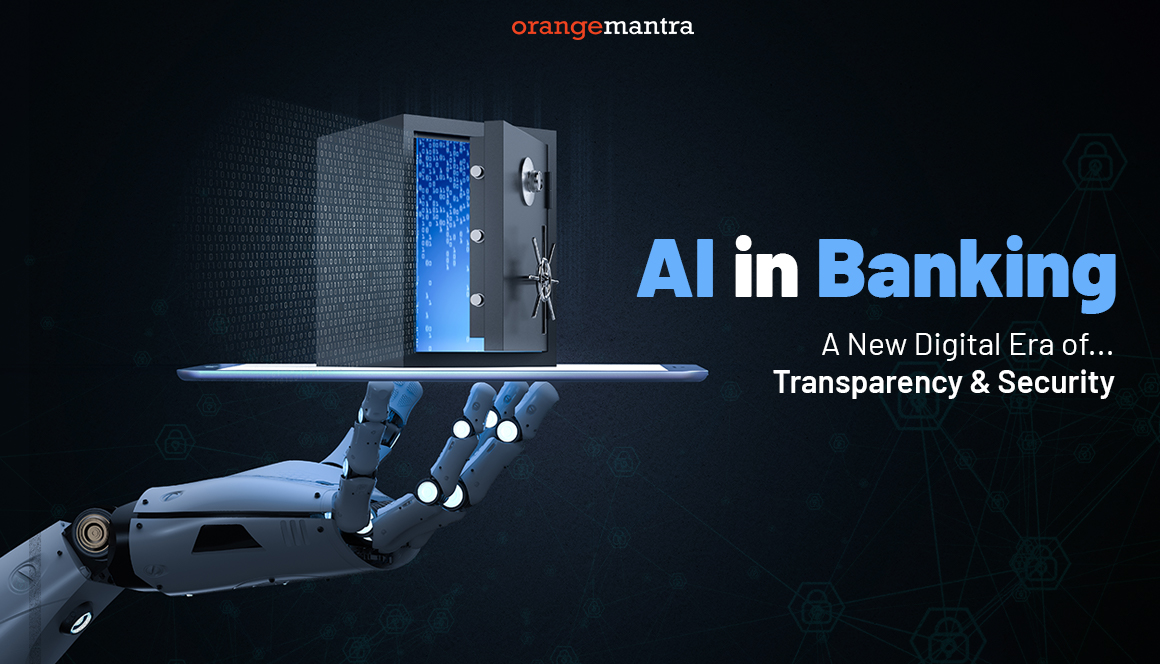
Here’s what you will learn:
Artificial intelligence technology has become a disrupter for many industries to rely on smart algorithms & improve decision making. Even the banking industry is no exception which is already experiencing the transformative virtues of AI. With the emergence of AI-driven Fintech app development company, the vertical is moving towards more agile, faster, and customer-centric operations at large.
AI in the banking sector has the potential to transform the multiple financial aspects from investing, spending to saving. It makes the transactional process goes seamless, smooth, and more customer-friendly.
The best use cases for understanding the potential of this emerging tech in the financial sector come from pioneer institutions.
*JPMorgan Chase has developed an early warning system with AI to quickly detect fraudulent emails, phishing, and trojans.
* Even Capital One is accessing the two-fold virtues of Artificial Intelligence technology. One is implementing Eno (a smart & intelligent virtual assistance to meet customers’ queries) and the other one is credit card fraud preventing functionality.
Undoubtedly, AI-based banking systems can help find errors, prevent frauds, increase productivity, and enhance decision-making skills. It helps to provide unfathomable data to the banking agents to best understand customer requirements and ideally serve them better with a personalized set of experiences.
To start integrating AI technology in the banking & finance sector, first, have a look at the number of applications to scale up your operations.
Table of Contents
Major Applications of AI in Banking
-
Chatbot-Smart Virtual Assistant
One of the best examples of an AI-driven solution in banking is Chatbot. It is a modernized way of meeting customers’ queries in a 24/7 running environment. A Chatbot delivers a personalized experience to users while providing accurate responses in real-time to enrich the trust factor on the enterprise.
As per the estimation, by the end of 2022, the banking system will automate 90% of its customers’ interactions by using Chatbot as the key driving factor.
By integrating Chatbot as pioneer Artificial Intelligence services in the banking enterprise, you can ensure:
* Round-the-clock customer support.
* Enhanced user experience.
* Recommended financial products/services.
-
Cybersecurity- Implementing Fraud Detection
Cyber threats and the financial vertical, are more or less synonymous with each other due to increasing digital transactions. Whether a user makes an online payment, deposit funds, withdraw money, and do more via mobile apps or websites, it results in extensive exchange of fiscal data across systems. And this is where the rising threat of cyber-attacks drops in.
But the solution lies with the Predictive Analysis functionality of AI technology to detect frauds, hacking activity, or any data of monetary data leakage. It helps to safeguard financial transactions, secure the user’s accounts, and find loopholes in the fiscal systems.
For instance, Danske Bank has implemented a fraud detection AI-powered algorithm to prevent fraudulent activities. It resulted in increasing the fraud detection capacity of the bank by 50%.
-
Smart Loan/Credit Card Assistant
Understanding the creditworthiness of a customer, while offering a loan or credit card is a common banking practice. Several banks follow the manual-based process of checking the credit history, payment defaults, and credit scores. However, this particular reporting system often results in possible flaws concerning errors and misleading information about transaction history.
The solution lies with an AI-based credit card and loan assistant that helps automate the credit checking process. The technology helps to understand the limited credit history of customers to quickly determine their creditworthiness and offer a particular fiscal offer.
-
Tracking Trends-Invest at the Right Time
The financial sector is endowed with an extensive scale of market information and processes a large volume of data. Industry-level experts make the best use of data to understand the latest market trends. By implementing the advanced Machine Learning techniques, investment bankers will evaluate deep inside the financial market to understand investing trends and supply the crucial information.
The amalgamation of Artificial Intelligence technology with the banking vertical helps investors find the right stock to invest in at the right time. And that too with the maximum possible gains. In short, emerging tech helps enrich the investment-related decision-making skills of traders.
-
Banking Process Automation
Banking Robotic Process Automation (RPA) algorithms help the sector reduce operational efforts, save time, and increase productivity to an optimum level. The technology helps automate repetitive tasks to maintain operational efficiency, accuracy, speed, and reduce errors. Moreover, it allows the professionals to focus more on enhancing the customer experiences by understanding their needs and preferences.
How Banks Can Adopt AI Into Their Operations
Implementing AI technology in banking requires a strategic and step-by-step approach to handle critical components of an enterprise. So, we have the process ready steps mentioned for you to avail the result-oriented virtues of the emerging tech.
1. Develop an AI Strategy
It all starts with developing an enterprise-level strategy based on particular goals and objectives to achieve.
* Find the gaps between your customers & the existing process that can be filled by AI.
* Make sure the emerging tech virtues meet with the industry-level guidelines.
* Evaluate the current international market trends.
* Transform the existing banking process.
2. Identifying Opportunities
* Find the possible opportunities aligned with the current business process.
*Conduct feasibility and usability checks while implementing artificial intelligence inputs.
* Identify and bridge the technology gaps to meet the desired objectives.
3. Development Process
* Execute the AI system functionality into the existing process.
* Build a prototype first to have an initial view of the agile system.
* Again, test the AI-implemented banking model to clear out errors and loopholes.
4. Seamless Monitoring
* Do continuous monitoring to measure the calibre and identify flaws.
* Comprehensive evaluation of the AI-banking system performance to identify strengths.
* Further scale up the operations as per the changing market trends and still become a pioneer in the marketplace.
The Future of Banking is AI-Dominated
It’s the AI-powered digital era that helps to understand and meet customer expectations at a personalized level. Implementing an AI-first bank approach will help provide intelligent experiences i.e., anticipating trends, analyzing errors, frauds, & behaviour, and offering timely product/service opportunities to customers. Thus, create and implement long-term and result-oriented AI solutions for the financial sector by relying on the expertise of an enterprise application development company i.e., OrangeMantra.
FAQs
1. What Are the Challenges of Implementing AI in Banking?
There are a few common challenges that might be faced by financial institutions while thinking to implement AI technology.
* Unable to leave the standard and conventional ways of operating the financial system to disturb the ongoing processes.
* Sometimes banks fail to comply with the much-needed technical reinvention due to having a lack of support of data and sources.
* Lack of trained professionals within the existing workforce is another major obstacle to finding it challenging to implement AI.
2. What Are the Key Benefits of AI in the Banking Sector?
* Improved customer acquisition, retention, and performance.
* Meeting the regulatory compliance & fraud detection with ease.
* Improved loan/credit card offering and facility evaluation.
* Critical analysis & evaluation to understand the fiscal market trends.
3. How to Implement AI in Finance & Banking Vertical?
To implement the emerging tech in the banking sector, there is a step-by-step process to follow that all starts with research & analysis, identifying opportunities, development, and monitoring.

